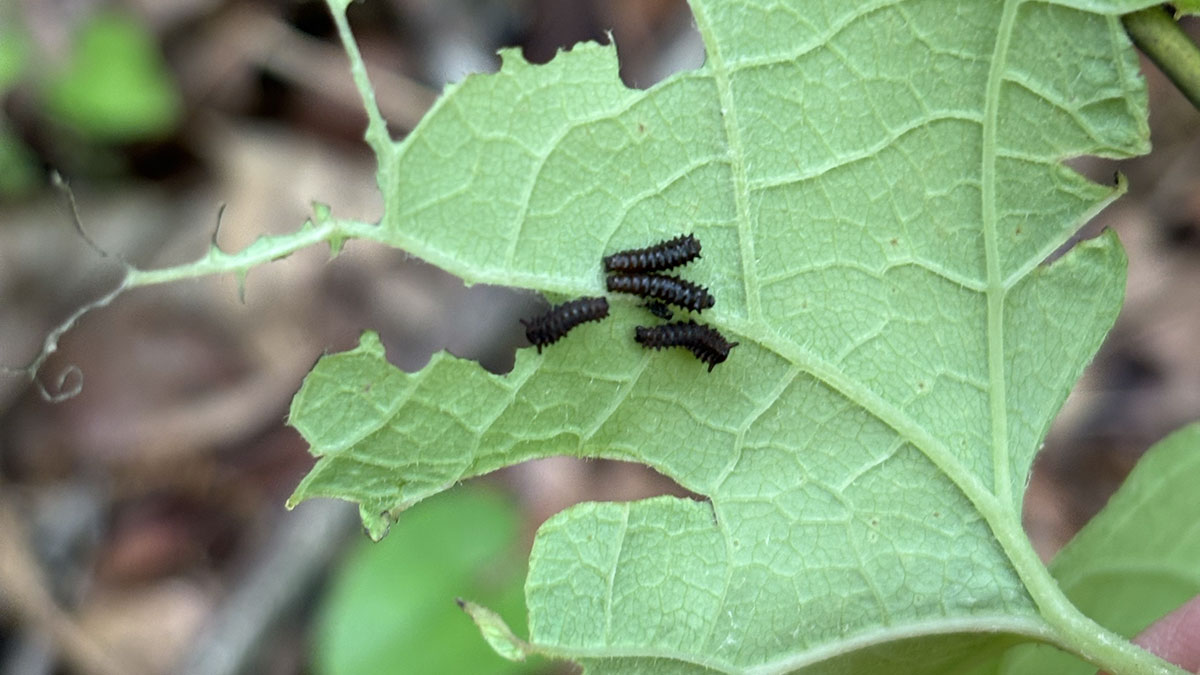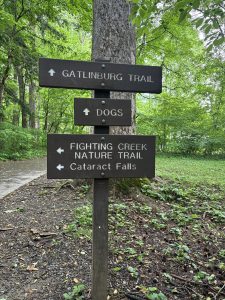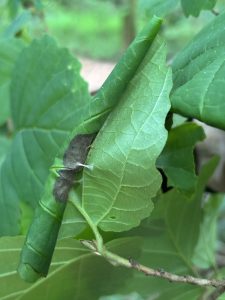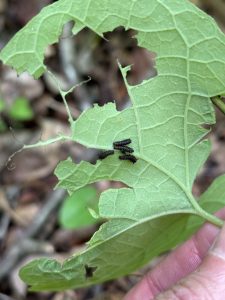
Talk about an auspicious start! Walking up to Sugarlands Visitor Center on the morning of the first full day of our Steve Kemp Writer’s Residency in Great Smoky Mountains National Park, we were greeted by a veritable swarm of our six-legged friends: amid zig-zagging silver-spotted skippers and gracefully fluttering tiger swallowtails, the flowering shrubs and wildflowers were abuzz with pollinators.

The reason was more than the season: it was the diversity of native plants in the lovely demonstration gardens of the visitor center, a nice illustration of the essential relationship between our native plants and the myriad insects that depend upon them.
And not just the insects: animals of all stripes all the way up the food chain. If the great web of ecological connectivity is envisioned as a pyramid, insects and their kin are the broad base on which all above it depends. This is because insects constitute the single largest group of animals on Earth, outnumbering all others in terms of species headcount and collectively outweighing them in terms of sheer body mass.
By occupying, at least on land, that crucial ecological niche between the verdant world of plants—those juiced-up photovoltaic cells of the organic world—and the rest of the animal kingdom, insects and their kin are the most important yet least understood and appreciated denizens of Great Smoky Mountains National Park. We aim to remedy that.
Our Kemp Residency will be spent working on an insect natural history field guide for the park, to be published by Smokies Life, a kind of celebration of insect diversity and a primer for getting to know our six-legged neighbors better. In addition to featuring a great many of the more conspicuous insect groups that park visitors will encounter, our guide will spotlight the less obvious but no less abundant insects, fascinating groups that are all around us but largely unseen.
Or are they? These creatures almost always leave clues to their presence, and it doesn’t take much practice to get your eye in and spot the signs. Think of it as an “insectan” scavenger hunt of sorts. Park visitors would be surprised at the diversity of insects all around them, on just about any trail.

Take the Fighting Creek Trail at Sugarlands, a leisurely loop near the Sugarlands Visitor Center that meanders through the most amazing population of creeping partridgeberry (Mitchella repens)—but that’s a story for another time. Walking this trail, we kept an eye out for insects and insect signs, and it didn’t take long to find loads of both: we soon spotted a dragonfly laying eggs in a quiet stretch of creek, and a lovely red-spotted purple butterfly (Limenitis arthemis) flitted between sunny patches on the forest floor.
A bit later we came across a pair of shining black bessbugs (Odontotaenius disjunctus), also given the apt moniker patent-leather beetles, crossing the trail. A hefty carpenter bee (Xylocopa virginica) investigated one tree trunk, and we were treated to a beautiful wasp probing another trunk with its long, slender ovipositor, an egg-laying structure. These wasps don’t sting people. They are called “parasitoids,” a kind of predator, really, that seeks out juicy insect larvae in which to lay its eggs, the hapless prey becoming a living larder.
Insect signs were even more abundant. We found not one but two kinds of leaf-roller caterpillar, one on Christmas fern and one on witch-hazel. The fern leaf-roller (Herpetogramma) is an inconspicuous little caterpillar that does a neat trick, chewing notches in the stiff central stem of a fern frond and applying silk guy-lines to re-roll the frond into a faux-fiddlehead. There the caterpillar will hide, feeding in safety on the fiddlehead shelter from the inside.
Another caterpillar occurred in abundance along this trail—or did recently, as evidenced by its calling card. Most of the many strawberry-bush (Euonymus americanus) or hearts-a-bustin’ shrubs that we observed trailside were curiously devoid of leaves, and delicate tracings of webbing left on the denuded stems told the tale: caterpillars of the tiny American ermine moth (Yponomeuta multipunctella) chowed down here. Most had finished their caterpillar career and were now encased in cocoons from which the small spotted adult moths will soon emerge.
Yet another neat caterpillar gave itself away in a beautiful trailside patch of Dutchman’s pipevine (Aristolochia). Most of the broad heart-shaped leaves of the vine were pristine, but one was a ragged mess from chewing. Whodunnit?

Dutchman’s pipevine is toxic to most insects, narrowing the possibilities, but in our region it’s almost certainly a particular culprit and a beautiful one at that: pipevine swallowtails! The caterpillars of this large swallowtail (Battus philenor) specialize on Dutchman’s pipevine, sequestering the toxic chemicals produced by the plant and turning them into their own defense. The ones we found were still very small, but the full-grown caterpillars are jet black with red spots, a color combination sure to get the attention of would-be predators.
This is a great example of warning coloration. While tasty green caterpillars hide out from birds, those that are well defended (whether through nasty chemicals, wicked spines, or gullet-choking hairiness) are more bold in color, as if they’re flaunting their defense. A bit later in the season we’ll see adult pipevine swallowtails, which are also toxic and attention-grabbing with black and iridescent blue on the wing uppersides and black with striking orange spots below. (In fact, this species is at the center of a complex of butterflies in the Smokies, including the red-spotted purple, that gain protection by mimicking the pipevine swallowtail’s color patterns.)
We came across quite a few other insect signs too: old bark beetle tracings, leaf galls, nibbled leaves, and more. Most hikers along the Fighting Creek Trail that day likely spotted the beautiful butterflies and bees and may have noticed the silken strands adorning the strawberry-bushes—and probably would have assumed spiders made them. But there were far more insects there on that one trail than met the eye, and through our field guide we hope to help nature-loving park visitors read the clues and get to know them!
Subscribe to get the latest posts sent to your email.
The Great Smokies Welcome Center is located on U.S. 321 in Townsend, TN, 2 miles from the west entrance to Great Smoky Mountains National Park. Visitors can get information about things to see and do in and around the national park and shop from a wide selection of books, gifts, and other Smokies merchandise. Daily, weekly, and annual parking tags for the national park are also available.